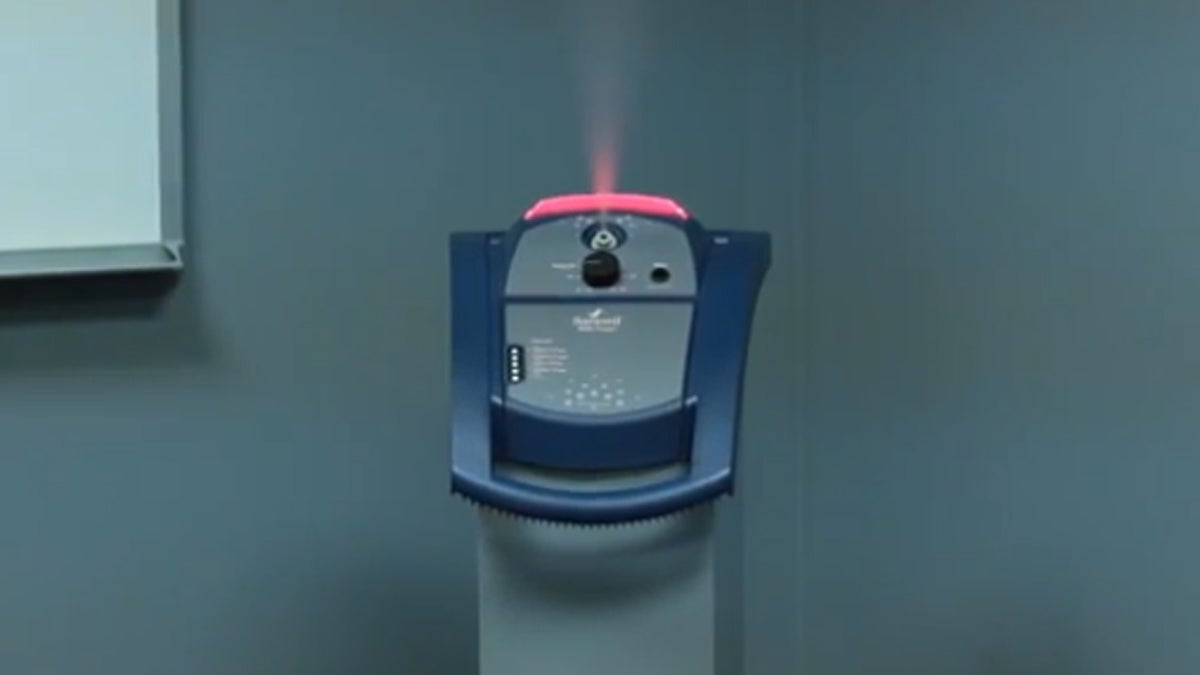Could fog disinfectant machines help fight the spread of Ebola?
Listen
(Photo courtesy of SanosilInternational)
Sanosil International and other companies that produce foggers say their tools can be more effective than traditional methods.
Inside a hospital, Patient A may never come into direct contact with Patient B. There could be hours or days between when the first gets discharged and the second is treated. In the interim, housekeeping crews clean and disinfect the room, wiping down surfaces with bleach-based products.
But even with a thorough sanitation effort, Patient B still faces a huge risk for contracting what the occupant before him carried.
“You go in with a broken leg, you come out with a MRSA infection that actually kills you,” says Chris Ungermann, CEO of Sanosil International, a Delaware company that produces disinfection systems.
The CDC estimates that 1-in-25 patients will acquire an infection in the hospital, leading to 75,000 deaths annually.
“That’s a shockingly high number,” says Ungermann.
Pathogens including Clostridium difficile (shortened to C. Diff.), MRSA and pneumonia can ravage a patient’s often-already weak immune system. In some cases, the infections can survive for days or longer outside of the body, hiding on equipment, walls or behind blinds.
Ungermann thinks he’s found a fix, in the form of a hydrogen-peroxide and silver-based disinfectant that disperses throughout a room like a fog moving across a landscape.
“It is all about concentration,” he says. “We are killing pathogens, living microorganisms, and we are actually filling up the room with enough active ingredient to touch every surface and sterilize it.”
To operate, the liquid disinfectant gets poured into a fogging device that resembles a slimmed-down airport self-service check-in machine on wheels. Flip it on, and the liquid gets aerosolized into what Ungermann calls a ‘dry fog.’ Within 90-minutes, a sealed hospital room is sanitized and ready for the next patient.
“It is 99.9999 percent effective,” says Ungermann.
You missed a spot
Today’s machine-filled hospital rooms offer pathogens no shortage of cracks and crevices to hide in, making manual application of bleach more challenging.
“The more technology you have in a room, the more surface area you have in a room, the more surface area you have, the more difficult it is to have a human actually clean it,” says Dr. John Stern, Chief of Infectious Diseases at Pennsylvania Hospital.
“We all know what it is like to try to dust at home,” he says. “Like myself, I don’t even bother.”
In 2011, an outbreak of C. diff. was moving through the hospital, eventually sickening more than 50 patients. Bleach was applied, and curtains were thrown away, but the infection persisted.
Stern and his team brought in five foggers to disinfect rooms, and found that it cut the transmission rate by more than half.
He says the technology is simple to use, but can be a challenge to operationalize.
“You’ve got to identify a contaminated room, housekeeping has to zip in there, they’ve got to fog the room which takes several hours, and then clear the room for the next patient. In a very busy hospital like ours, a two-hour delay in moving a new patient in can be a bit challenging, but not insurmountable.”
Addressing the Ebola threat
Another challenge right now for hospitals is the threat of Ebola, and how to ensure complete decontamination.
Both Sanosil and other companies that produce foggers say their tools can be more effective than traditional methods in slowing the spread of the virus. But the CDC’s Dr. Matt Arduino, chief of the Clinical and Environmental Microbiology Branch, says it isn’t clear yet if they would in fact work better in the field.
“What we don’t have is actual data with the virus itself,” he says.
The CDC does list Sanosil’s Halo Disinfection System as an approved disinfectant against Ebola, but it also lists nearly 200 others, and doesn’t give any one method priority over another.
Chris Ungermann says aid groups just aren’t able to give his 50-pound machine, with its $7,000 price tag and power cord, a shot right now in West Africa, where Ebola has claimed nearly 6,000 lives.
“A lot of agencies were really not available to look at new technology,” he says. “They were overwhelmed, they were understaffed, and they defaulted back to chlorine bleach.”
Sanosil has delivered a handful of units to Nigeria, but the company also faces bureaucratic headaches and cultural differences.
The barriers, he admits, are frustrating.
“It has been. There is no doubt that the reaction could have been quicker, and I’m convinced that lives could have been saved by deploying our technology more rapidly.”
His team is continuing to work on logistics, but in the meantime, Sanosil also has other targets for its machines, including nursing homes, hotels, airplanes, and cruise ships.
WHYY is your source for fact-based, in-depth journalism and information. As a nonprofit organization, we rely on financial support from readers like you. Please give today.



